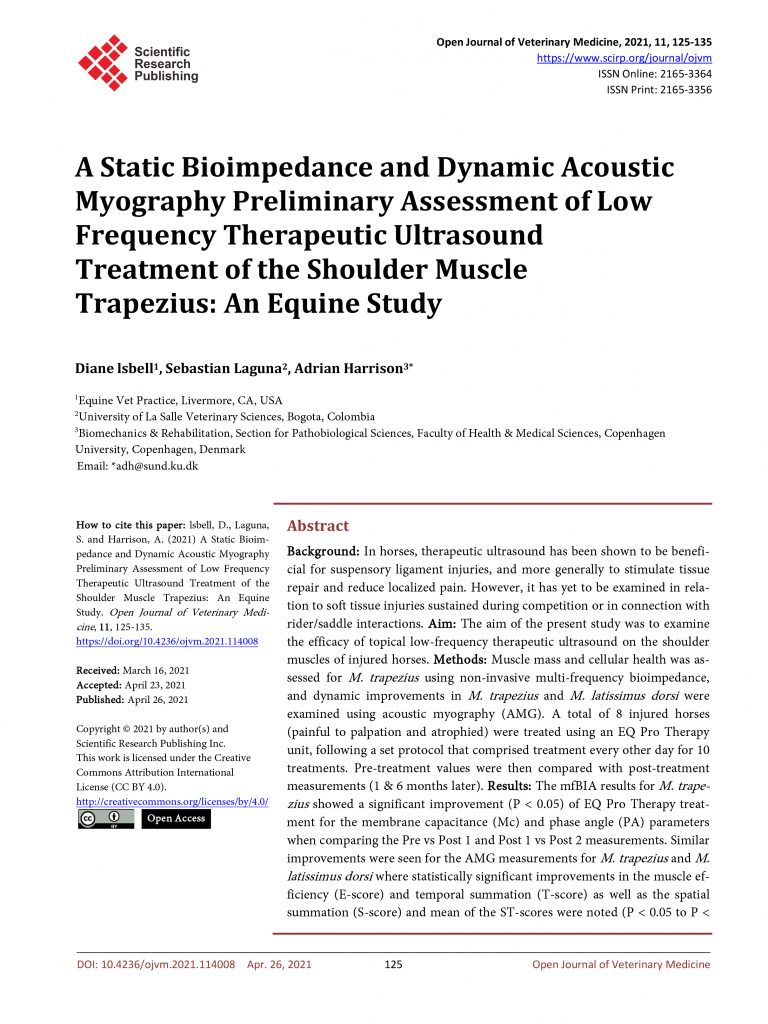A Static Bioimpedance and Dynamic Acoustic Myography Preliminary Assessment of Low Frequency Therapeutic Ultrasound Treatment of the Shoulder Muscle Trapezius: An Equine Study.
Open Journal of Veterinary Medicine > Vol.11 No.4, April 2021
Diane lsbell 1, Sebastian Laguna 2, Adrian Harrison 3*
1 Equine Vet Practice, Livermore, CA, USA.
2 University of La Salle Veterinary Sciences, Bogota, Colombia.
3 Biomechanics & Rehabilitation, Section for Pathobiological Sciences, Faculty of Health & Medical Sciences, Copenhagen University, Copenhagen, Denmark.
ABSTRACT
Background: In horses, therapeutic ultrasound has been shown to be beneficial for suspensory ligament injuries, and more generally to stimulate tissue repair and reduce localized pain. However, it has yet to be examined in relation to soft tissue injuries sustained during competition or in connection with rider/saddle interactions. Aim: The aim of the present study was to examine the efficacy of topical low-frequency therapeutic ultrasound on the shoulder muscles of injured horses. Methods: Muscle mass and cellular health was assessed for M. trapezius using non-invasive multi-frequency bioimpedance, and dynamic improvements in M. trapezius and M. latissimus dorsi were examined using acoustic myography (AMG). A total of 8 injured horses (painful to palpation and atrophied) were treated using an EQ Pro Therapy unit, following a set protocol that comprised treatment every other day for 10 treatments. Pre-treatment values were then compared with post-treatment measurements (1 & 6 months later). Results: The mfBIA results for M. trapezius showed a significant improvement (P < 0.05) of EQ Pro Therapy treatment for the membrane capacitance (Mc) and phase angle (PA) parameters when comparing the Pre vs Post 1 and Post 1 vs Post 2 measurements. Similar improvements were seen for the AMG measurements for M. trapezius and M. latissimus dorsi where statistically significant improvements in the muscle efficiency (E-score) and temporal summation (T-score) as well as the spatial summation (S-score) and mean of the ST-scores were noted (P < 0.05 to P < 0.01). Conclusion: The present findings suggest that EQ Pro Therapy treatment is efficacious in terms of equine cases involving soft tissue shoulder muscle injuries (painful to palpation and atrophied). The main improvements noted were not only increased muscle mass and cellular health but also improved force production, better coordination, and lateral balance, which persisted for at least six months after treatment.
Keywords
Horse, Skeletal Muscle, Acoustic Myography, Low Frequency Ultrasound
click here to view article on OJVM website
click here to download article in PDF

